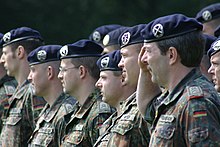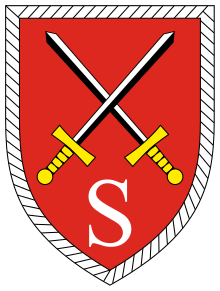Officer Candidate Battalion
The officer candidate battalions (OA-Btl) of the Bundeswehr in Munster and Hammelburg are the two training associations for officer candidates in the army . Since July 2006, the entire basic training of junior army officers and army uniforms of the armed forces base has been carried out in these battalions.
From August 2005, the battalions were prepared for commissioning by the respective deployment groups and grew to full strength in the first half of 2006. The permanent staff, and thus the trainers, come from all branches of the army and the armed forces base. In June 2006, the OA battalions Munster and Idar-Oberstein were awarded the troop flags, the OA battalion Hammelburg received them a month later. On July 3, 2006, the first recruits of the 76th Officer Candidate Class (OAJ) began their service in the associations. The OA Battalion Idar-Oberstein was dissolved at the end of 2012 and the OA Btl Munster was renamed OA Btl 1 and the OA Btl Hammelburg in OA Btl 2.
Structure / subordination
The officer candidate battalions belong to the organizational area of the training command and are either affiliated with one of the schools of the army or one of the centers of the army .
In detail:
-
 OA-Btl 1 in Munster the training center Munster ,
OA-Btl 1 in Munster the training center Munster , -
 OA-Btl 2 in Hammelburg to the infantry training center .
OA-Btl 2 in Hammelburg to the infantry training center .
The OA Battalion 1 reports directly to the head of the central area, a colonel. The central area itself is subordinate to the training center Munster, whose commander is a brigadier general .
The OA Battalion 2 reports directly to the head of teaching / training, a colonel. This is subordinate to the commander of the infantry training center in the rank of brigadier general who is also general of the infantry .
The battalions differ from the usual structure of battalions in the army. They consist of a battalion command group ( commander , personnel management, planning) and three training companies. These each consist of a leadership group and four trains . In total, each of the OA battalions has a nominal strength of around 400 soldiers, but the actual workload varies depending on the number of officers of the respective officer candidate year group (OAJ).
tasks
On July 1 of each year, recruits from one year of the officer candidate class take up their service in the officer candidate battalions. In six months they complete the Officer Candidate Course (OAL), which, in addition to basic training , weapons service and sporting components, also includes lessons in military law , political education and the basics of tactics . The training is supplemented by a military training area and further training, such as fire extinguishing training. Furthermore, a train from OA Btl 2 took part in the British exercise "Dynamic Victory".
Following these training phases in the OA-Btl, the officer candidates complete their first military internships at various locations, ten-week English language training in Idar-Oberstein and the officers' course (part 1) at the Army Officer School . The respective officer candidate battalion remains part of the main troop until the officer candidates are transferred to one of the Bundeswehr universities to study .
From January to July, the battalions hold the Infantry Competence Extension (LIKE) course, which replaces the lone fighter course in the new training course for all branches of service that are not assigned to combat troops . In the first year after the establishment (1st + 2nd quarter 2007) the OA-Btl carried out general basic training (AGA) for the Army Office and its subordinate departments.
Uniform and badge

The soldiers of the officer candidate battalions wear the uniforms of the army of the German Federal Armed Forces according to the Central Service Regulations (ZDv) 37/10. A special feature is the navy blue beret that the members of the battalion wear with the beret badge of their military branch. The budding mountain hunters also wear the navy blue beret with the beret badge of the hunter troop and the edelweiss to ensure uniformity.
The soldiers can wear the association badge in the form of a chest tag on the right breast pocket with their service suit or field suit. It shows the Iron Cross on a blue background, underneath the crossed swords. The coat of arms is overwritten with the respective location. The badge of the superordinate agency (worn as a patch on the left sleeve of the service suit) is based on the school that "houses" the battalion. It always shows two crossed swords as a symbol for the army on a red background, as well as an "S" as a symbol for a military school. With the exception of the "S" in its basic form it corresponds to the coat of arms of the Army Office. The badge is outlined according to the weapon color of the troop type that corresponds to the respective school.
criticism
The change in the training course for the army officer candidates led to massive criticism from the older generation, which has meanwhile also been taken up by the Defense Commissioner of the German Bundestag :
The most frequently expressed criticism of the new training structure is that the officer cadets lost touch with the troops and barely had any leadership experience at group and platoon leader level . This is particularly due to the fact that the officer cadets and officers with a degree usually only get to know the normal troop units for a maximum of three months during the first six years of their training and then, after completing their training for the type of service after their studies, as inexperienced first lieutenants often already deputy company commanders and often even representing company commanders.
The lack of commitment to the officer's profession (“job thinking”) and the elimination of the decisive development phase of the young officer cadets are objected to in the ranks of the officer and non-commissioned officer corps, as is the shortening of general military training areas and the reduction in specialist knowledge specific to the troop branch in the early phase of training . However, it is noted that the new training structure of the army in the broadest sense represents an alignment with the structures of the navy and air force, which in no way have to contend with a lack of commitment to the officer profession.
The transfer of specialist knowledge specific to the troop branch in the later course of training is due, on the one hand, to the fact that in the old training model fully trained officers were transferred from the troops to one of the two universities of the Bundeswehr for three to four years , which was time-consuming and costly after graduation Refreshing of the unlearned or re-teaching of knowledge that has become obsolete made necessary. On the other hand, the new training model for personnel management enables a more flexible handling of constantly changing personnel requirements. This avoids costs that, in the past, B. originated from the fact that a certain number of officers of one type of service was fully trained, but during the study time of these officers a downsizing of their type of service meant that the personnel requirement had to be drastically reduced. As a result, fully trained officers had to be rescheduled after graduation and completely re-trained in new assignment lines. Since the young officer candidates of the new training structure are only trained in general military until the end of their studies and their military branches are only assigned provisionally, the personnel management can finally decide at the end of the course on the basis of current figures how high the personnel requirements of each military branch is and initiate appropriate measures if necessary .
Lecturers at the universities of the Bundeswehr advocate that army soldiers now come to the universities after just 15 months, instead of only after three years of service as before. All officer candidates are now on the same level, since the time between the Abitur and the beginning of the studies is almost the same in each military branch.
The first officers of the 76th OAJ, those without a degree, were deployed for the first time in early 2010 in troop assignments as platoon commanders, company operations officers and / or deputy company commanders. A final evaluation of the new training structure is still premature at the moment, but so far the initial fears that the new structure would lead to “job thinking” in the ranks of the officers or to a generally poor quality of training have not materialized. In the middle / end of 2011 the first bachelor graduates of the 76th OAJ started their first military assignments. In mid-2012, the broad masses of Masters and the final diploma graduates followed .
Incidents
During an acclimatization march on July 19, 2017 at the Munster site, four officer candidates suffered a circulatory collapse and had to be treated in hospitals. One of these officer candidates died in hospital on July 29, 2017. The investigation of causes and circumstances continues.
Web links
Individual evidence
- ↑ http://augengeradeaus.net/wp-content/uploads/2011/10/Heer_Grobststruktur_oct2011.jpg ( page no longer available , search in web archives ) Info: The link was automatically marked as defective. Please check the link according to the instructions and then remove this notice.
- ↑ Annual report of the Armed Forces Commissioner 2009 (PDF; 2.9 MB). Chapter 4.6: Training. Website of the German Bundestag. Retrieved October 31, 2010.
- ↑ Candidate officer died in hospital. Retrieved July 30, 2017 .
- ^ Bundeswehr soldiers collapse during training march. In: Hamburger Abendblatt. July 26, 2017. Retrieved July 30, 2017 .


